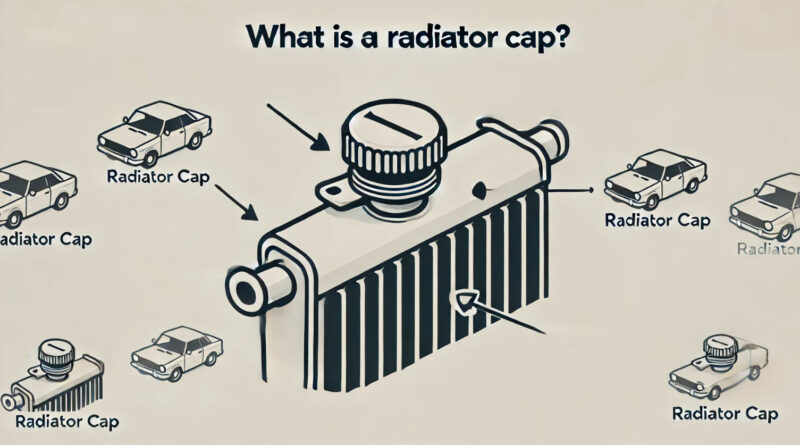What Is Radiator Cap, and Why Does It Matter?
It’s easy to overlook something as small as the radiator cap when it comes to your car, but this little part plays a huge role in keeping your engine happy and healthy. Think of it as the unsung hero of your cooling system, working quietly to prevent your engine from overheating.
What Does a Radiator Cap Do?
Your radiator cap is more than just a lid for the radiator. It’s like a gatekeeper for your car’s cooling system, keeping everything running smoothly by:
- Keeping the Pressure Just Right: Your engine’s cooling system works best under pressure—it stops the coolant from boiling even when the engine gets hot. The cap keeps that pressure steady, usually between 13 and 16 psi, depending on your car.
- Managing Coolant Flow: When your engine heats up, the coolant expands. The cap lets the extra coolant move into the overflow tank, stopping it from spilling everywhere. Once the engine cools, it pulls the coolant back into the system.
- Protecting Your Engine: By keeping things pressurized and preventing coolant loss, the radiator cap helps avoid engine overheating—a major cause of costly repairs.
How Does It Actually Work?
The cap might look simple, but it’s packed with a clever little mechanism. Here’s how it works:
- Seals the System: The cap creates an airtight seal, making sure coolant stays inside.
- Regulates Pressure: Inside the cap is a spring-loaded valve that releases pressure if it gets too high, allowing coolant to flow into the overflow tank.
- Allows Coolant Return: When the engine cools down, the cap’s valve opens up to let coolant flow back into the radiator.
It’s a small part, but without it, your cooling system can’t do its job properly.
Signs Your Radiator Cap Might Be in Trouble
A failing radiator cap can lead to a cascade of cooling system problems. Here are some red flags to watch for:
- Your Engine Overheats: If the cap isn’t maintaining pressure, your engine could overheat—never a good sign.
- Coolant Leaks: A worn-out cap might let coolant escape, leaving puddles under your car.
- Collapsed Hoses: Without proper pressure, the hoses can actually collapse from suction.
- Low Coolant Levels: If the cap doesn’t let coolant flow back from the overflow tank, your radiator can run low.
How to Check Your Radiator Cap
Checking your radiator cap is easy and can save you from bigger issues down the line. Here’s how to do it:
- Wait for the Engine to Cool: Always let your engine cool completely before touching the cap—hot coolant can be dangerous.
- Inspect the Cap: Look for cracks, rust, or damage to the rubber seal.
- Test the Spring: Gently press on the spring inside the cap. If it feels loose or doesn’t bounce back, it might be time for a replacement.
Why the Radiator Cap Deserves More Love
This little cap plays a massive role in keeping your car running smoothly. It keeps the cooling system pressurized, prevents coolant loss, and protects your engine from overheating. A faulty radiator cap might seem like a minor issue, but ignoring it can lead to some serious (and expensive) problems.
Replacing a Radiator Cap: Easier Than You Think
If your radiator cap is showing signs of wear, replacing it is a quick fix that you can often do yourself:
- Find the Right Cap: Match the replacement cap to your car’s specs, including its pressure rating.
- Wait for the Engine to Cool: Safety first—never open a radiator cap on a hot engine.
- Swap It Out: Twist the old cap off, put the new one on, and make sure it’s securely in place.
It’s a simple task, but it can make a big difference in how your car runs.
Pro Tips for Keeping Your Cooling System Healthy
A happy radiator cap is just one part of a healthy cooling system. Here are a few tips to keep everything in top shape:
- Check Coolant Levels Often: Low coolant is a surefire way to overheat your engine.
- Look for Leaks: Keep an eye out for puddles under your car—coolant leaks can spell trouble.
- Flush the System Regularly: Flushing old coolant and replacing it helps prevent buildup and corrosion.
- Pay Attention to Temperature Gauges: If your engine is running hotter than usual, don’t ignore it.
Final Thoughts
The cap might not get much attention, but it’s a vital part of your car’s cooling system. It keeps the pressure balanced, helps manage coolant flow, and ensures your engine doesn’t overheat.
Regularly checking and replacing your radiator cap, when needed, is a small but important step in keeping your car running smoothly. So the next time you pop the hood, take a moment to appreciate the little cap that’s doing big work for your engine.
Buying a used VW. Buying used vauxhall, BMW, Jaguar, Ford, Volvo, Range rover, Bentley, Aston Martin, Porsche, Ferrari, Lamborghini, Maserati, Hyundai, Tesla, Honda, Pagani

